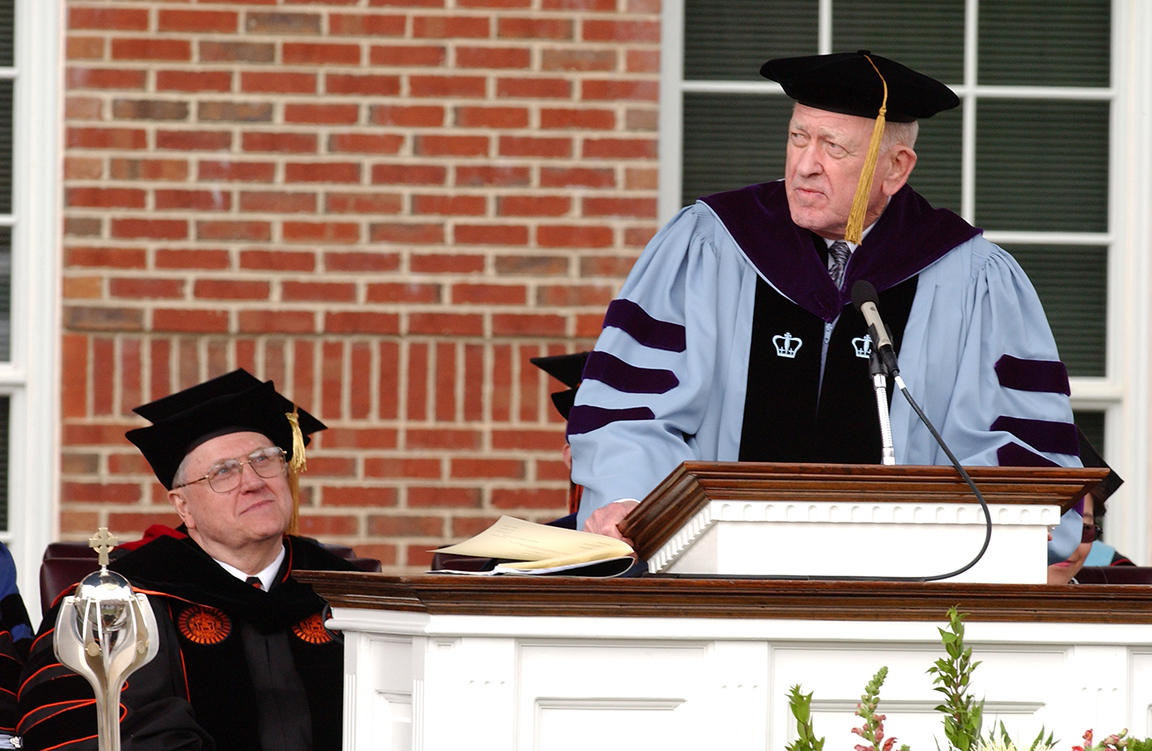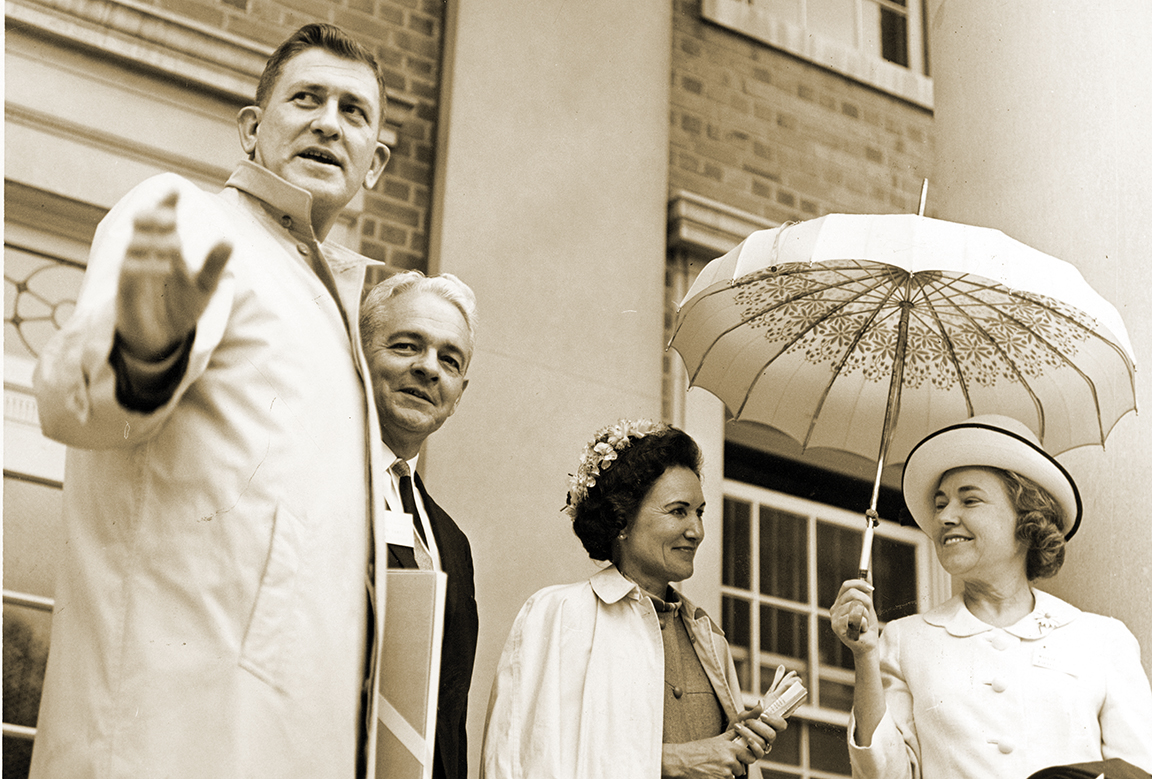Ed & Millie | Their love. Their legacy.
By Billy Liggett
 erry Wallace pulls up an old wooden side chair next to the bed and eases himself down onto it. His old friend — they’ve known each other nearly 50 years — is sitting up, supported by a bundle of pillows, an afghan covering her legs.
erry Wallace pulls up an old wooden side chair next to the bed and eases himself down onto it. His old friend — they’ve known each other nearly 50 years — is sitting up, supported by a bundle of pillows, an afghan covering her legs.
“Oh Jerry,” she says, her voice soft. Brittle. “My mind is not as sharp as it used to be.”

Wallace smiles.
“You’re going to be surprised when you talk to her,” he assures us with a wink.
He turns back to his friend. “And Millie. That mind … it’s still sharp. I’d say it’s matured.”
“It’s gone,” Millie Wiggins yields. We’re in the bedroom of her home in Keith Hills. She’s surrounded by boxes, papers, envelopes, scrapbooks and photos. Wallace sits to her left. We’ve pulled up a few chairs at the foot of the bed.
Millie will turn 99 this year. She doesn’t leave the house much these days. Visits from friends aren’t as routine as they used to be. But today is special.
Today, we’re here to talk about Ed.
“You just wait,” Wallace tells us. “That mind of hers. You’ll be amazed.”
As if on cue, Millie brings us back to January 1947, the first day of school at Campbell College after Christmas break. It’s below freezing that day, and the class is huddled around the radiator in the back of the room when she walks in.
“That’s when I first saw Ed,” Millie says, referring to the tall, handsome new guy among the group keeping their hands warm. “Or rather … that’s when Ed first saw me. My friends told me later that he asked, ‘Who is that girl?’”
 t’s been nearly 12 years since Norman Adrian Wiggins, Campbell University’s third president who held the office for 36 years, lost his lengthy battle with lymphoma. He was first diagnosed in 2003, news that led to his stepping down as president that same year.
t’s been nearly 12 years since Norman Adrian Wiggins, Campbell University’s third president who held the office for 36 years, lost his lengthy battle with lymphoma. He was first diagnosed in 2003, news that led to his stepping down as president that same year.
He died in a Winston-Salem hospital on Aug. 1, 2007, at the age of 86.
“He fought it,” Wallace says, reaching for Millie’s hand. “Nobody fought harder than Dr. Wiggins did.”
And he left behind shoes that Wallace says nobody could fill.
Consider just Page 1 of Wiggins’ list of accomplishments. The School of Law that bears his name. The College of Pharmacy & Health Sciences (the nation’s first new pharmacy school in 40 years when it launched in 1986). One of the country’s most renowned ROTC programs. The nation’s first (and still only) four-year trust and wealth management program. Campbell’s growth from a newly minted senior college in 1967 to a full-fledged university in 1979. Campbell’s presence at North Carolina’s military bases and on the other side of the world in Kuala Lumpur, Malaysia. The Lundy-Fetterman School of Business. The School of Education. The Divinity School. The enrollment of Campbell’s first black student during his first year in office.
Not as “big,” but important nonetheless — Wiggins lifted the ban on dancing on campus in 1970, allowed students to have telephones in their dorm rooms and OK’d big name acts to perform concerts on campus.
“The years of the Wiggins administration have been heady years,” wrote J. Winston Pearce in his second volume of A Big Miracle in Little Buies Creek in 1985, “a sort of intoxicating, high-voltage, exhilarating experience has gripped the time and the place.”
Jerry Wallace had been at Campbell for 31 years and was provost for nearly 18 when he decided to step down as Wiggins’ right-hand man in 2001. Wallace wanted to step out of the limelight and focus on his first love — teaching — at the Divinity School for the remainder of his career. Then President Wiggins became ill.
He was in the 37th year of his presidency. Before him, Leslie Hartwell Campbell led the school for 33 years. His father, founder J.A. Campbell, was president for 47 years. Wallace, who was 68 at the time, had no plans on working into his late 90s. And he had no intentions of becoming president.
But this was the wish of his mentor. And to understand Wallace’s ultimate decision to become just the fourth president of Campbell University in 116 years, we must understand the strength of the friendship that had formed over the previous 31. Wallace calls working with Wiggins one of the greatest joys of his life.
“I’ll preface all of this by saying Dr. Wiggins was the best man I’ve ever known,” Wallace says. “Clean. Honorable. Trustworthy. Considerate. Loving. Generous.
“He was a superb leader — in terms of the quality of a human being, the goodness of a human being and the purity of a human being,” he says. “When it came time for me to be president, I’d already walked a lot of miles with a very good man.”
“To know him is to love him,” adds Millie. “And he loved you, too, Jerry.”
Wallace smiles. “I’m deeply indebted to Millie and Dr. Wiggins for believing I could make a difference here at Campbell.”
Wallace would go on to be president for 12 years after initially promising his mentor he would give him at least five. His presidency would be marked by the addition of new schools and programs, though he credits much of it — such as the Jerry M. Wallace School of Osteopathic Medicine and the John W. Pope Jr. Convocation Center — to the vision Wiggins introduced back in the late 1960s.
“He laid the groundwork for all of it,” Wallace says. “He had courage, and he elicited courage from the people around him. It took courage to open a law school. It took courage to open a pharmacy school. His example laid the groundwork for the medical school. He’s the reason all of it is here today.”
 erry Wallace was the first and only candidate considered to succeed Wiggins as president in 2003. Thirty-six years earlier, Norman Wiggins was the 32nd and final candidate to be approached by the school to succeed Leslie Campbell.
erry Wallace was the first and only candidate considered to succeed Wiggins as president in 2003. Thirty-six years earlier, Norman Wiggins was the 32nd and final candidate to be approached by the school to succeed Leslie Campbell.
At the time, he was an attorney who had recently helped a search committee at Wake Forest University find the replacement for its most recent president, Harold Tribble. When Leslie Campbell announced his retirement, the committee responsible for finding his replacement was aware of Wiggins’ ties to Campbell and his involvement in the Wake Forest search.
“The committee thought it could get Dr. Wiggins to help shorten their list,” says Wallace. “So he came, and during their talks, one of the men on the committee said, ‘Why, my soul, he should be on our list. Dr. Wiggins should be our president.’”
“My name was last in the barrel,” Wiggins would later say. “When they came to me, [they] didn’t have anywhere else to go.”
While the “last choice” story makes for compelling history, Wallace says Wiggins was the only man who could truly follow in the footsteps of what he calls “The Campbell Dynasty” — 80 years of leadership under father and son.
“Everything Dr. Wiggins and Millie had done up to that point prepared them for this moment,” Wallace says. “They were perfect for Campbell.”
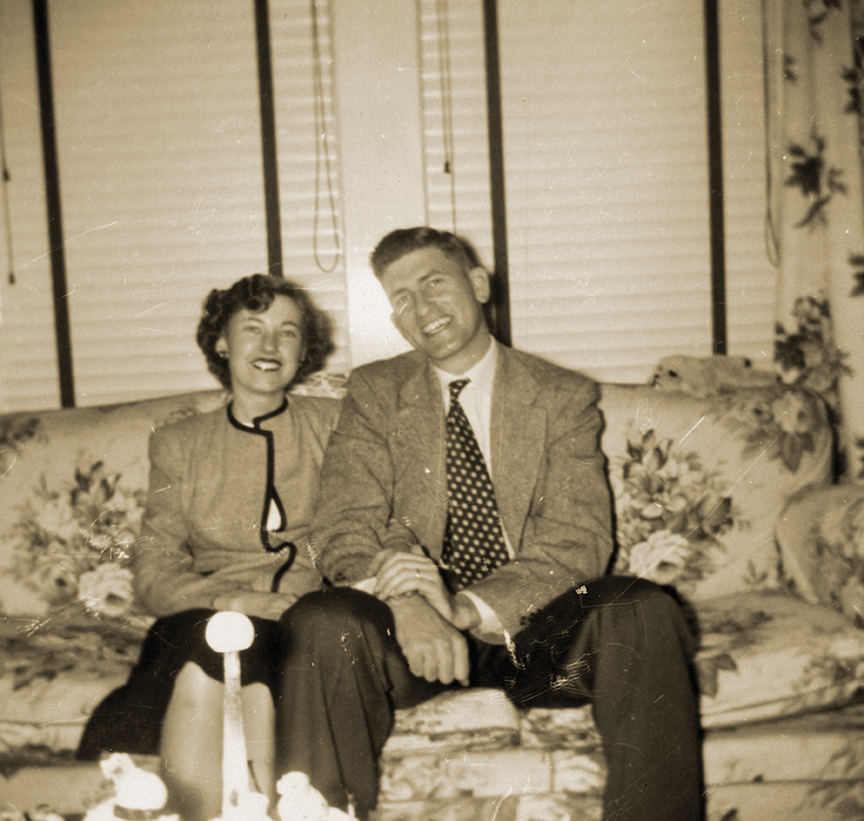 It was in Buies Creek where the couple fell in love in 1947 — the year after Norman Wiggins returned home from World War II (he served in the Pacific, a radio operator who saw his fair share of combat). Millie recalls early in their relationship when her new boyfriend first met her parents.
It was in Buies Creek where the couple fell in love in 1947 — the year after Norman Wiggins returned home from World War II (he served in the Pacific, a radio operator who saw his fair share of combat). Millie recalls early in their relationship when her new boyfriend first met her parents.
“The first time he came over to my house, he thumbed his way over,” she says. “He didn’t have a car, but I did back then. We did most of our courting in the car. Sitting there, talking, studying French.”
Her story comes as a surprise to Wallace, who coming in thought he knew everything about their story. “That’s the first time I’ve heard about him hitching to your house,” he says. “And you courted in the car? You were supposed to be studying, weren’t you?”
“We were!” Millie says defensively, followed by a smile.
“Millie,” Wallace follows. “When you looked at Dr. Wiggins and sized him up … what did you see?”
She pauses a moment to gather her thoughts. Then closes her eyes.
“He was a fine person. A truly good person,” she says. “Someone I could respect and love.”
Norman graduated from Campbell Junior College (Millie still had a semester to go) and both continued their education at Wake Forest, which was still located in the town of Wake Forest at the time. While students there, the two returned to Buies Creek and got married at First Baptist Church.
By now, Millie has an old album spread across her lap, filled with sepia-toned photos of their wedding, their trips together and of “the trailer.”
“Yeah,” she says with a smile, pointing to a their home, which was more like the kind of camper you’d see hitched to a Buick in the 1950s. “That’s our trailer. We added a little room to it eventually … and look, Jerry. There’s my garden. I had a little garden outside of the trailer. We didn’t even have a bathroom — they’d built a common bathroom we shared with three families. Oh, we loved our little trailer.”
 That little trailer got the couple through Norman’s law school years, and in 1952, they moved to Rocky Mount, where he went to work for Planters National Bank. Three years later, Wake Forest moved to Winston-Salem, and the university wanted Norman to come back and teach at the law school. They sent him to New York that year to earn his doctorate at Columbia University. Millie also attended Columbia, earning her master’s degree in education. Both did so in less than a year.
That little trailer got the couple through Norman’s law school years, and in 1952, they moved to Rocky Mount, where he went to work for Planters National Bank. Three years later, Wake Forest moved to Winston-Salem, and the university wanted Norman to come back and teach at the law school. They sent him to New York that year to earn his doctorate at Columbia University. Millie also attended Columbia, earning her master’s degree in education. Both did so in less than a year.
“There were very few doctors of law,” Wallace says. “And I’m not talking juris doctorate … this was an SJD [Doctor of Juridical Science]. He may have been the only faculty member at Wake Law at the time with a doctorate. That move took courage, and it was good experience for him.”
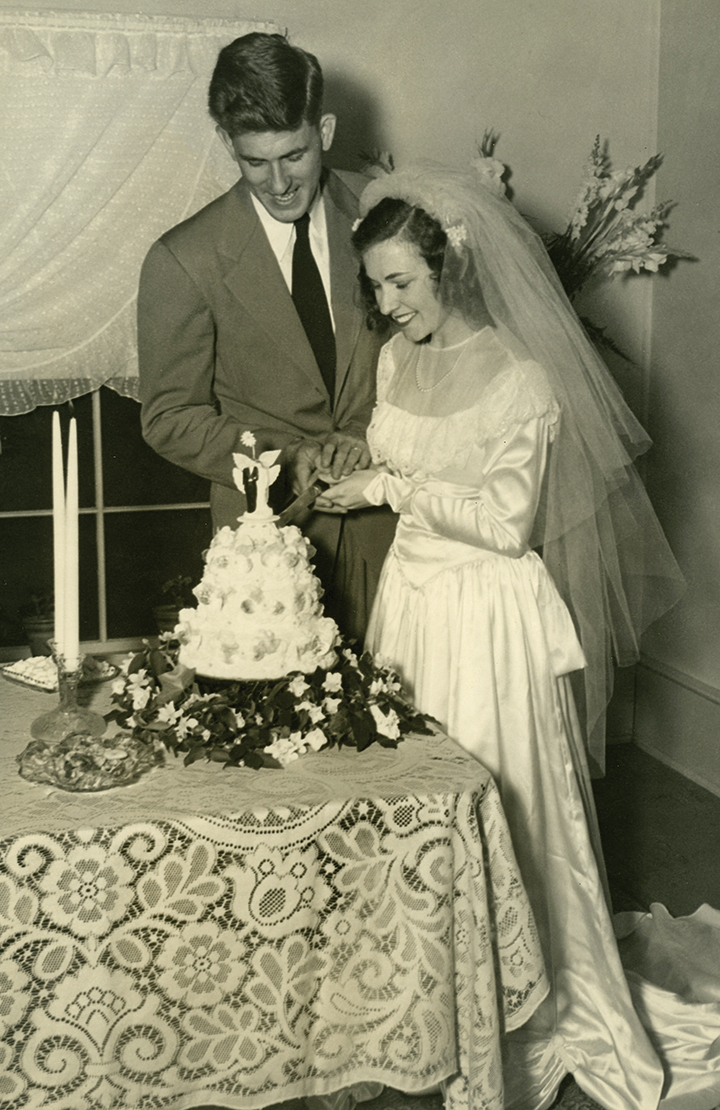 The Wiggins spent 11 years — 11 happy years — in Winston-Salem. Millie worked full time for the university, and Norman (in addition to teaching) published Wills and Administration of Estates in North Carolina in 1965, a book now in its fourth edition that’s still used by law schools to cover fundamental rules of estate laws and local taxes.
The Wiggins spent 11 years — 11 happy years — in Winston-Salem. Millie worked full time for the university, and Norman (in addition to teaching) published Wills and Administration of Estates in North Carolina in 1965, a book now in its fourth edition that’s still used by law schools to cover fundamental rules of estate laws and local taxes.
By this time, Norman Wiggins was a much-sought-after commodity in higher education circles. He’d been approached by Furman, Richmond and, most intriguing of all, NYU. The latter didn’t sit all that well with Mrs. Wiggins.
“We were in Boston for a conference, and while we were there, somebody cornered him about coming to NYU,” she recalls. “So on our way home, we stopped in New York and met with some people there. I think it excited Ed … he asked me later, ‘What do you think about going to New York and living there?’
“Well, I had lived in New York for a year already,” she adds. “So I told him, ‘Ed, if you want to commute, you may work in New York.’ And that ended that.”
By the time Norman was part of the Campbell search committee — and eventually, the prize of the search committee — in 1967, he was ready to lead. That didn’t mean returning to Campbell was an easy decision for either him or Millie.
“It was a tough time for Campbell,” Wallace says. “Enrollment was plateauing, and the school was in debt. But Dr. Wiggins believed he was called here, and that word ‘calling’ was very important to him. They believed the Lord would lead if he responded. And so Millie and Dr. Wiggins packed up from that nice place in Wake Forest and came to Buies Creek with no place to live.”
They’d move three times in their first year before finding the home in Keith Hills. It’s been Millie’s home for 50 years now.
 orman Wiggins and Jerry Wallace were in Charleston, South Carolina, in 1985, ready to stand before the accreditation committee of the American Pharmaceutical Association and ask for approval to launch the nation’s first new pharmacy school in 40 years.
orman Wiggins and Jerry Wallace were in Charleston, South Carolina, in 1985, ready to stand before the accreditation committee of the American Pharmaceutical Association and ask for approval to launch the nation’s first new pharmacy school in 40 years.
No pressure.
“Here was a little school in Buies Creek — nobody in that room would even know where it was,” Wallace says. “And we were going to ask for this.”
The two were staying in a quaint hotel, the Lodge Valley Inn, in downtown Charleston, and on the morning of the accreditation hearing — as the two men were leaving — Wiggins stopped Wallace and asked him to join him in prayer.
“Here we were, a lawyer and a preacher,” Wallace says through a grin. “And Dr. Wiggins drops to his knees beside his bed and begins to pray. ‘Lord,’ he said, ‘give us understanding and help us. If it’s not your will, don’t let this be done.’
“Well, I heard that and said, ‘Lord, don’t pay any attention to what he just said.’ Of course it was going to be His will.”
And it was.
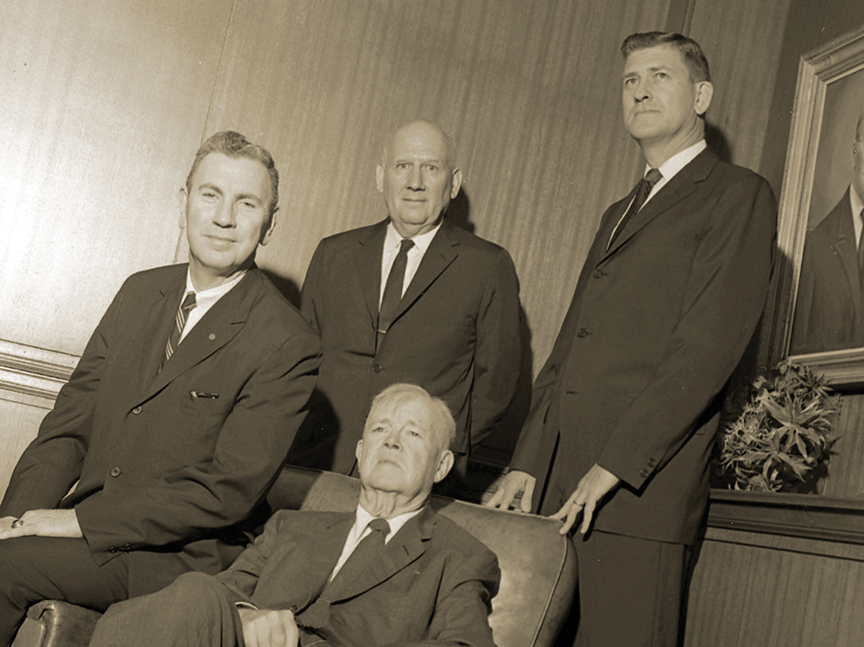 North Carolina didn’t just need more pharmacists in the 1980s; it needed more like the one Wiggins grew up visiting in Burlington — a community pharmacist who worked just around the corner from where the young man lived and who could address a range of health needs. UNC-Chapel Hill was home to the only pharmacy degree program in the state at the time, and Wallace’s research as provost revealed a shortage of pharmacists in North Carolina, especially in rural areas.
North Carolina didn’t just need more pharmacists in the 1980s; it needed more like the one Wiggins grew up visiting in Burlington — a community pharmacist who worked just around the corner from where the young man lived and who could address a range of health needs. UNC-Chapel Hill was home to the only pharmacy degree program in the state at the time, and Wallace’s research as provost revealed a shortage of pharmacists in North Carolina, especially in rural areas.
In August 1986, Campbell welcomed its first pharmacy students, 55 of them. Today, the College of Pharmacy & Health Sciences is home to one of the premier pre-pharmacy programs in the United States, a recently launched Bachelor of Science in Nursing program and seven graduate programs. The school’s success paved the way for the School of Osteopathic Medicine in 2013.
“The establishment of the pharmacy school turned this University around,” Wallace says. “Dr. Wiggins knew those students would come here, because they were thirsty for [careers in this field], and there was water here. And you’ll go where the water is. It elevated our science holdings and our science faculty in ways we never imagined.”
Norman Wiggins’ legacy at Campbell University will forever live on in the programs he launched, the first being the nation’s first undergraduate, four-year trust and wealth management program in 1968. He was one of the nation’s leading authorities on trust law (he “wrote the book”); and he had contacts to make a partnership with the North Carolina Bankers Association, which led to the creation of the Southeastern Trust School.
Two years later, Campbell officially launched a new ROTC program at a time when many schools were dissolving their programs because of the unpopular war in Vietnam. Campbell became the first school in the Southeast to offer a major in military science.
Trust and ROTC were appetizers for Wiggins’ biggest legacy. In early 1973 — not even six years into office — Wiggins called an executive session with is Board of Trustees and Presidential Advisors to inform them of his intentions of starting a law school.
 Wallace — who was an adjunct sociology professor for Campbell at the time but still two years away from joining the college full-time — was serving as a pastor in Elizabethtown when he first heard the “rumors” of Wiggins’ grand plan. He was in Raleigh for a meeting of the Baptist State Convention — the gathering was located next to the building that houses the law school today — and he recalls voting to approve Campbell’s initiative (which required approval from the organization’s committee on higher education). It was a big day for Wallace, for more than one reason.
Wallace — who was an adjunct sociology professor for Campbell at the time but still two years away from joining the college full-time — was serving as a pastor in Elizabethtown when he first heard the “rumors” of Wiggins’ grand plan. He was in Raleigh for a meeting of the Baptist State Convention — the gathering was located next to the building that houses the law school today — and he recalls voting to approve Campbell’s initiative (which required approval from the organization’s committee on higher education). It was a big day for Wallace, for more than one reason.
“I walked across the street from my hotel and introduced myself to Dr. Wiggins that day,” Wallace says. “And that’s where I met him. It’s also where I voted — I remember that day made a lot of other university and college presidents jealous. Dr. Wiggins made them jealous a lot of times in his career.”
Not everybody was on board. The editorial board of the Raleigh News & Observer notoriously castigated the school’s existence. The state’s economy at the time was tenuous, and most private colleges were trimming their budgets (some even closing their doors). North Carolina was already home to four law schools — now was not the time for a fifth, they argued.
“We know the rest of the story,” Wallace says. “And we were so proud of it. It was huge that a school like Campbell was doing this. The bottom line was that we were going to teach students to go out and serve in underserved areas. One of the joys I still have today is traveling across the state and when I go to a church, nine times out of 10 someone will come up to me and tell me they graduated from Campbell Law. And you see them doing good.”
In his career at Campbell, Norman Wiggins was an advocate for private education and the primary leader for the cause in North Carolina. He lobbied legislators for state funding, he made several close friends in Raleigh and Washington, D.C., who championed the cause — many of them wanted to see Wiggins enter the political arena (something Millie says he seriously considered at one point). In the fall of 1986, Norman and Millie Wiggins traveled to D.C. to visit the White House, where they presented President Ronald Reagan with a copy of Big Miracle at Little Buies Creek to celebrate Campbell’s centennial.
During his 40-year tenure as president and chancellor, Campbell University’s endowment grew from less than $1 million to nearly $100 million, and the total University assets were valued at $140 million. Enrollment on the main campus had grown to 3,482, and total enrollment in the system was at 9,220.
And by his side the entire time was Millie. The two traveled the world together — conventions in Ireland or Great Britain; the launch of a new Campbell program in Malaysia. But there was also a lot of loneliness, as Wallace points out. A lot was required of the president of Campbell University.
“Millie spent a lot of time by herself,” Wallace says. “A lot of time. But she never complained. Not once. And the day I became president, the one piece of advice she gave me was, ‘Don’t stay gone for too long. Don’t stay gone as much.’ It wasn’t easy on her. And I never forgot that advice.”
 erry Wallace was a “poor cotton mill boy” from Rockingham.
erry Wallace was a “poor cotton mill boy” from Rockingham.
He says Norman Wiggins was a “poorer cotton mill boy” from Burlington.
“Dr. Wiggins and I talked many, many times about our childhoods,” Wallace says. “They had a cow and a garden, and they lived close enough to town where he could walk there. I joked a lot that he was an ‘uptown mill boy,’ because I lived two miles out of town, and seldom walked there. I suppose that was the big difference.”
Wiggins told his family early on that he wanted to attend college. The easiest way for young men with his background got into college was through sports. He excelled in numerous sports in high school, and he was recruited to attend Campbell in 1942 to play basketball. That August, he and his friend Erwin Sykes hitchhiked their way to Buies Creek to enroll and start practice, but when they arrived, the school had no record of any recommendation from his coach and no record of any athletic scholarship being offered.
But Wiggins was invited to stay by President Leslie Campbell, as all men’s teams at the time were depleted because of the start of World War II. “Go ahead and enroll,” Campbell told Wiggins. “We’ll work it out someway.” The young man worked as a janitor in Layton Hall during his first semester and helped keep the tennis courts clean that fall.
From janitor to president.
 “There’s a story I remember from a classmate of his,” Wallace says. “The man said he knew Dr. Wiggins would be somebody special; because at the end of football and basketball practice, instead of running inside and taking a shower, Dr. Wiggins would stay behind and help the manager with the equipment and anything else that needed to be taken in.
“There’s a story I remember from a classmate of his,” Wallace says. “The man said he knew Dr. Wiggins would be somebody special; because at the end of football and basketball practice, instead of running inside and taking a shower, Dr. Wiggins would stay behind and help the manager with the equipment and anything else that needed to be taken in.
“I teach a class at the medical school on servant leadership, and I still use that example to this day. A real leader is a servant long before people look to him to lead. And Dr. Wiggins was that way as a child. He was that way in high school, that way in college and that way in life.”
College was interrupted the following year when Wiggins joined the Marines and served in the Pacific. He clung to his faith to get him through the war — ”Dr. Wiggins had a strong faith,” Wallace says. “A simple faith and a deep-meaning faith.”
Millie recalls Psalm 97, a passage Wiggins held close to his heart and a passage that his father passed down to him.
The Lord reigns, let the earth be glad; let the distant shores rejoice.
Clouds and thick darkness surround him; righteousness
and justice are the foundation of his throne.
Fire goes before him and consumes his foes on every side.
His lightning lights up the world; the earth sees and trembles.
The mountains melt like wax before the Lord, before the Lord of all the earth.
The heavens proclaim his righteousness, and all peoples see his glory.
Millie, too, had dreams of attending college. After high school, she took business classes in Salisbury while living with a cousin. But her mother fell ill after a year, and Millie returned to Coats to help take care of her. She found a job at Fort Liberty at the start of the war, working for the quartermaster and saving every dime she earned for college. For fun, she attended USO dances with her friends.
“Eventually, I had enough working at Liberty, and I tried to quit in the summer [of 1945] so I could attend school that fall, but the captain refused and said, ‘You can’t leave. The war’s not over.’” she says. “Well, in September, the war was over. So that same day, while everyone was celebrating, I walked over and handed him my resignation and said, ‘You can’t keep me any longer.’ I started at Campbell that fall.”
Which leads us to the beginning. 1947. That cold January morning in a classroom at Campbell Junior College. Ed Wiggins, fresh from the war, huddled around a radiator with his new classmates before the start of class.
“There were two Adrians that year,” Millie says with a smile. “Dean [A.R.] Burkot told them one had to be Ed, and one had to be Ad. When I met him, he was Ed. And he was always Ed.”
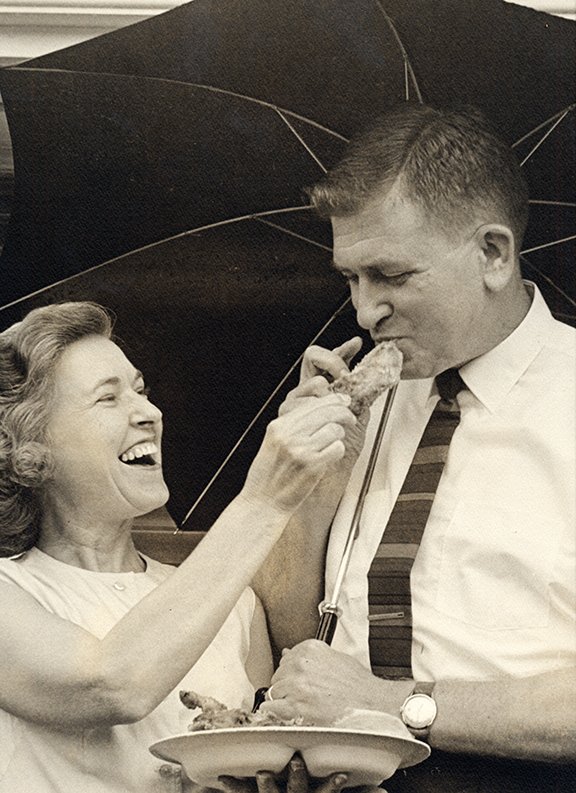 “And I never called him that,” Wallace says. “My mouth would sink into the ground if I ever called him anything other than Dr. Wiggins. And if I ever do, take me to a psychiatrist.”
“And I never called him that,” Wallace says. “My mouth would sink into the ground if I ever called him anything other than Dr. Wiggins. And if I ever do, take me to a psychiatrist.”
Millie remembers seeing the tall, handsome new guy for the first time as she entered the classroom that morning, longing to join them around the heater.
“That’s when I first saw Ed,” she says. “Or rather … that’s when Ed first saw me. My friends told me later that he asked, ‘Who is that girl?’
“I walked in and went to my desk so I could put my books down,” she says. “I walked over to the radiator and told him I was Mildred Harmon, from Coats. And that was it. A year later, we were married.”
You just wait.
“All my life, I wanted a college education,” she adds.
That mind of hers.
“I wanted to do something besides working in the tobacco fields. Something besides milking cows twice a day and selling milk and butter in Coats.”
You’ll be amazed.
“I wanted something bigger. And that decision led me to Ed. And the rest was history.”
***
Editor’s Note: Millie Wiggins died at the age of 98 a few months after her interview for this story. She spent the 12 years following her husband’s death working hard to preserve his legacy at Campbell University — her agreeing to do a nearly two-hour interview while bed-ridden is only further proof of her determination. Our condolences go out to her many friends and family.


